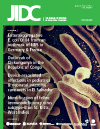Identification of feline immunodeficiency virus subtype-B on St. Kitts, West Indies by quantitative PCR
DOI:
https://doi.org/10.3855/jidc.1844Keywords:
feline immunodeficiency virus, fluorescence resonance energy transfer (FRET) PCR, CaribbeanAbstract
Introduction: Although antibodies to the feline immunodeficiency virus (FIV) have been detected by SNAP assay in cats from St. Kitts, there have been no molecular studies to further confirm the infection and determine the FIV subtypes present.
Methodology: Total nucleic acids were extracted from EDTA whole blood specimens from 35 cats, followed by quantitative fluorescence resonance energy transfer (FRET) PCR under a six-channel LightCycler 2.0 Instrument with Software version 4.1.
Results: Four of 11 stray cats (36 %) but none of 24 owned cats were FIV positive by real-time PCR. High-resolution melting curve analysis indicated that all four positive cats were infected with FIV subtype-B.
Conclusions: This is the first molecular characterization of FIV subtypes on St. Kitts and the results confirm the high prevalence of FIV infection in stray cats on the island.
Downloads
Published
How to Cite
Issue
Section
License
Authors who publish with this journal agree to the following terms:
- Authors retain copyright and grant the journal right of first publication with the work simultaneously licensed under a Creative Commons Attribution License that allows others to share the work with an acknowledgement of the work's authorship and initial publication in this journal.
- Authors are able to enter into separate, additional contractual arrangements for the non-exclusive distribution of the journal's published version of the work (e.g., post it to an institutional repository or publish it in a book), with an acknowledgement of its initial publication in this journal.
- Authors are permitted and encouraged to post their work online (e.g., in institutional repositories or on their website) prior to and during the submission process, as it can lead to productive exchanges, as well as earlier and greater citation of published work (See The Effect of Open Access).








